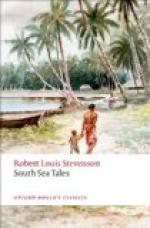There is one great personage in the Gilberts: Tembinok’ of Apemama: solely conspicuous, the hero of song, the butt of gossip. Through the rest of the group the kings are slain or fallen in tutelage: Tembinok’ alone remains, the last tyrant, the last erect vestige of a dead society. The white man is everywhere else, building his houses, drinking his gin, getting in and out of trouble with the weak native governments. There is only one white on Apemama, and he on sufferance, living far from court, and hearkening and watching his conduct like a mouse in a cat’s ear. Through all the other islands a stream of native visitors comes and goes, travelling by families, spending years on the grand tour. Apemama alone is left upon one side, the tourist dreading to risk himself within the clutch of Tembinok’. And fear of the same Gorgon follows and troubles them at home. Maiana once paid him tribute; he once fell upon and seized Nonuti: first steps to the empire of the archipelago. A British warship coming on the scene, the conqueror was driven to disgorge, his career checked in the outset, his dear-bought armoury sunk in his own lagoon. But the impression had been made; periodical fear of him still shakes the islands; rumour depicts him mustering his canoes for a fresh onfall; rumour can name his destination; and Tembinok’ figures in the patriotic war-songs of the Gilberts like Napoleon in those of our grandfathers.
We were at sea, bound from Mariki to Nonuti and Tapituea, when the wind came suddenly fair for Apemama. The course was at once changed; all hands were turned-to to clean ship, the decks holy-stoned, all the cabin washed, the trade-room overhauled. In all our cruising we never saw the Equator so smart as she was made for Tembinok’. Nor was Captain Reid alone in these coquetries; for, another schooner chancing to arrive during my stay in Apemama, I found that she also was dandified for the occasion. And the two cases stand alone in my experience of South Sea traders.
We had on board a family of native tourists, from the grandsire to the babe in arms, trying (against an extraordinary series of ill-luck) to regain their native island of Peru. Five times already they had paid their fare and taken ship; five times they had been disappointed, dropped penniless upon strange islands, or carried back to Butaritari, whence they sailed. This last attempt had been no better-starred; their provisions were exhausted. Peru was beyond hope, and they had cheerfully made up their minds to a fresh stage of exile in Tapituea or Nonuti. With this slant of wind their random destination became once more changed; and like the Calendar’s pilot, when the ‘black mountains’ hove in view, they changed colour and beat upon their breasts. Their camp, which was on deck in the ship’s waist, resounded with complaint. They would be set to work, they must become slaves, escape was hopeless, they must live and toil and die in Apemama,




